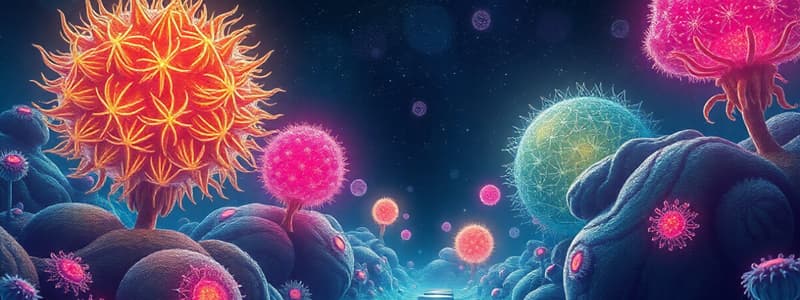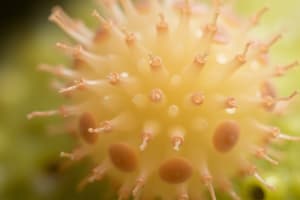Podcast
Questions and Answers
What characteristic distinguishes protists from bacteria?
What characteristic distinguishes protists from bacteria?
- They lack membrane-bound organelles.
- They are primarily heterotrophic.
- They have a nucleus. (correct)
- They are multicellular organisms.
Which of the following correctly describes protozoans?
Which of the following correctly describes protozoans?
- They are all capable of photosynthesis.
- They belong to the kingdom Plantae.
- They are primarily autotrophic organisms.
- They are unicellular and exist as heterotrophs. (correct)
What method do zooflagellates use for movement?
What method do zooflagellates use for movement?
- Spreading cytoplasm.
- Releasing spores.
- Utilizing flagella. (correct)
- Using cilia.
Which example represents a sporozoan?
Which example represents a sporozoan?
Which of the following protozoans is known for using a pseudopod for movement?
Which of the following protozoans is known for using a pseudopod for movement?
How do sporozoans reproduce?
How do sporozoans reproduce?
What is the primary feeding mode of heterotrophic protists?
What is the primary feeding mode of heterotrophic protists?
Which characteristic is typical of ciliates?
Which characteristic is typical of ciliates?
Which protist is primarily known for helping digest cellulose in wood?
Which protist is primarily known for helping digest cellulose in wood?
What type of organism is classified as fungus-like among protists?
What type of organism is classified as fungus-like among protists?
Which of these statements correctly describes the characteristics of protists?
Which of these statements correctly describes the characteristics of protists?
Which supergroup of protists primarily consists of heterotrophic organisms?
Which supergroup of protists primarily consists of heterotrophic organisms?
What distinguishes sarcodinians from other protozoans?
What distinguishes sarcodinians from other protozoans?
Which of the following protozoans is known for having flagella?
Which of the following protozoans is known for having flagella?
What is a key characteristic of sporozoans?
What is a key characteristic of sporozoans?
Which of the following lacks means of locomotion?
Which of the following lacks means of locomotion?
What kind of protists are classified as autotrophs?
What kind of protists are classified as autotrophs?
What is the primary function of cilia in ciliaphorans?
What is the primary function of cilia in ciliaphorans?
Which statement is true regarding zooflagellates?
Which statement is true regarding zooflagellates?
Which of the following is a characteristic shared by all protozoans?
Which of the following is a characteristic shared by all protozoans?
Flashcards are hidden until you start studying
Study Notes
Prokaryotes and Eukaryotes
- Prokaryotes lack a nucleus and membrane-bound organelles.
- Eukaryotes possess a nucleus.
Protists
- Most are unicellular.
- All are classified as eukaryotes.
- Divided into 4 supergroups.
Protist Nutrition
- Heterotrophs: animal-like.
- Autotrophs: plant-like.
- Decomposers: fungus-like.
Protozoans (Animal-like Protists)
- Unicellular
- Eukaryotic
- Heterotrophic
- Capable of movement.
Sarcodines
- Move using cytoplasmic extensions called pseudopods.
- Example: Amoeba.
Zooflagellates
- Possess whip-like structures called flagella for movement.
- Example: Trichonympha (digests cellulose in termites).
- Example: Trypanosoma (transmitted by tsetse flies and causes African Sleeping Sickness).
Ciliates
- Largest group of protozoans.
- Covered in tiny hair-like projections called cilia.
- Example: Paramecium.
Sporozoans
- Non-motile.
- Parasitic.
- Reproduce both sexually and asexually.
- Example: Plasmodium (causes malaria).
- Sporozoites (immature sporozoans) are transmitted through fluids.
Prokaryotes vs Eukaryotes
- Prokaryotes are single-celled organisms that lack a nucleus and other membrane-bound organelles.
- Eukaryotes are organisms whose cells have a nucleus and other membrane-bound organelles.
Protists
- Mostly unicellular organisms
- Eukaryotic
- Classified into four "Supergroups"
- Exist as heterotrophs, autotrophs, or decomposers.
Protozoans (animal-like protists)
- Unicellular, eukaryotic, and heterotrophic
- Classified based on movement
- Classified as Sarcodines, Zooflagellates, Ciliaphorans, and Sporozoans.
Sarcodines
- Move by extending cytoplasm (pseudopods)
- Example: Amoeba
Zooflagellates
- Move using flagella (whip-like extensions)
- Examples: Trichonympha (lives in termite guts) and Trypanosoma (causes African Sleeping Sickness, transmitted by tsetse fly)
Ciliaphorans (Ciliates)
- Largest group of protozoans
- Covered with cilia (hair-like projections)
- Example: Paramecium
Sporozoans
- Non-motile, spore-forming, parasitic protozoans
- Can reproduce sexually and asexually
- Live inside or on animals
- Example: Plasmodium (causes malaria)
- Immature sporozoans (sporozoites) are transmitted through fluids
Studying That Suits You
Use AI to generate personalized quizzes and flashcards to suit your learning preferences.




